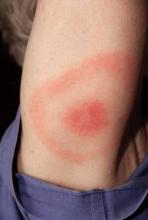When erythema migrans recurs a year or more after standard courses of antibiotic therapy for Lyme disease, it most likely represents a reinfection from another tick bite, not a relapse of the first infection, according to a report published online Nov. 15 in the New England Journal of Medicine.
The limited clinical and epidemiologic evidence has suggested that such cases probably represent new infections – but some have argued that they could instead be relapses, citing animal experiments in which Borrelia burgdorferi persisted despite antibiotic treatment, said Dr. Robert B. Nadelman of the division of infectious diseases, New York Medical College, Valhalla, and his associates.
To settle the question, Dr. Nadelman and his colleagues analyzed the genotypes of the infecting organisms in a study of 17 adults who had a total of 22 paired episodes of erythema migrans between 1991 and 2011. The study subjects all were enrolled in prospective studies of Lyme disease at New York Medical College, and had provided skin and blood specimens for culture of B. burgdorferi before being treated with standard antibiotics. All skin lesions resolved with therapy.
All of the 9 men and 8 women were believed to have acquired the infections in the Lower Hudson Valley region of New York state. Their median age was 47 years (range, 27-80 years at the time of the first episode of erythema migrans).
In every case, the second episode of erythema migrans occurred from 1 year to 15 years after the first episode. The median duration of the interval between episodes was 4 years.
The investigators did not identify the same genotype in any of the 22 paired episodes in any patient. All the second episodes of erythema migrans were caused by a strain that was genotypically distinct from the organism that had caused the first episode.
Moreover, a second genotyping method confirmed infection by a different genotype of B. burgdorferi in all 22 paired episodes, the investigators said (N. Engl. J. Med. 2012;367:1883-90 [doi: 10.1056/NEJMoa1114362]).
These findings "provide further evidence of the success of antibiotics in eradication of B. burgdorferi from the skin of patients with erythema migrans in the United States," Dr. Nadelman and his associates said.
Other evidence also suggested that these patients experienced reinfections rather than relapses. In 20 (91%) of the cases, the recurrence developed during the summer months, paralleling the activity of the vector that likely was responsible.
"It is unlikely that a relapsed infection would have such a seasonal distribution when there is a delay of 1 year or more between episodes," the investigators noted.
The study was supported in part by the National Institutes of Health and the William and Sylvia Silberstein Foundation. Dr. Nadelman reported serving as a consultant to Decision Resources and Guidepoint Global, and his associates reported ties to Abbott, Baxter, and other companies.


